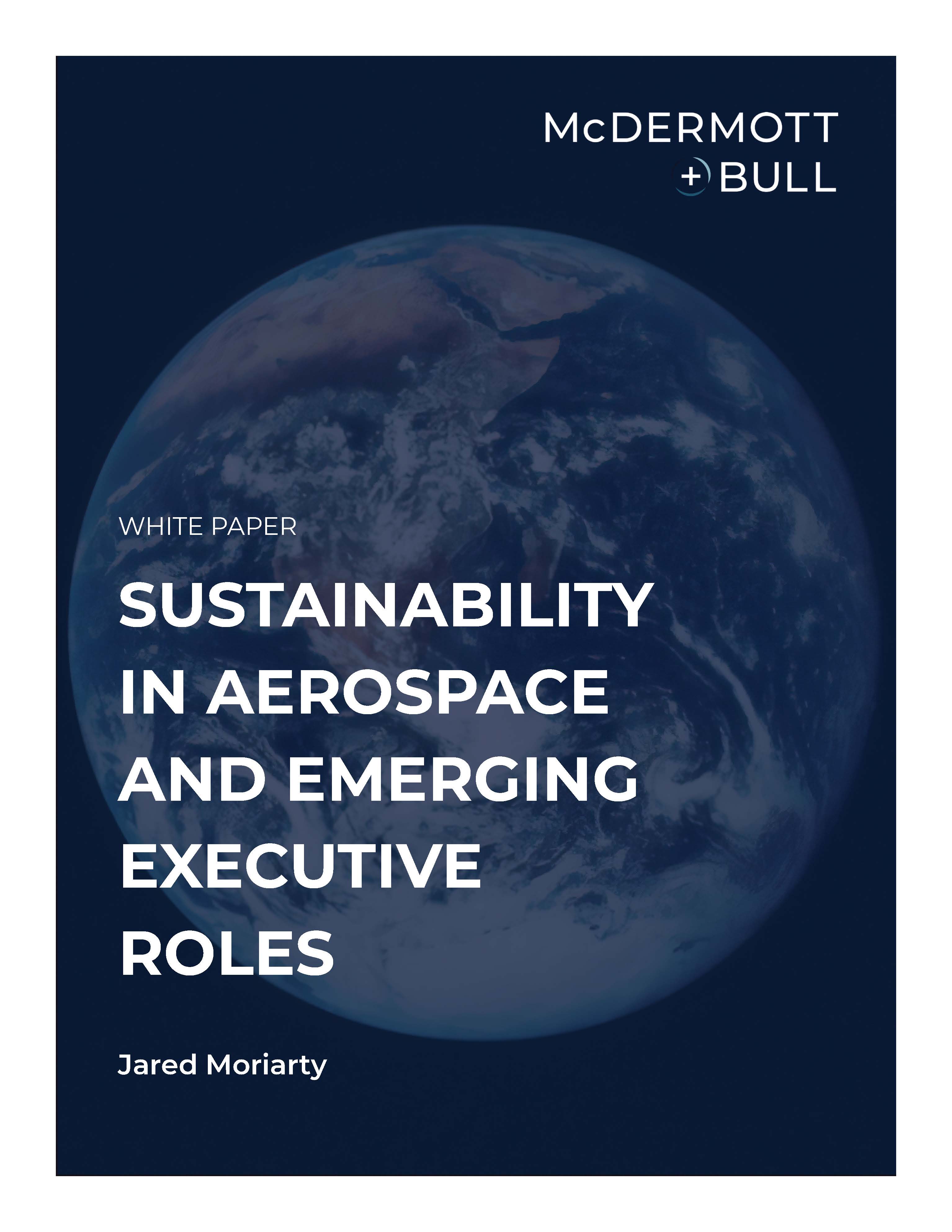The “S” Word — How the Aerospace Industry is Focusing on Sustainability and the Rising Prominence of the Head of Sustainability Role
There is no doubt that the COVID-19 pandemic, the U.S. election, and social justice issues have taken most of the spotlight this past year — and rightfully so. However, over the past few months, we have been hearing a significant increase in discussion around environmental concerns. Now that the aerospace industry is beginning to look forward in the recovery from COVID-19, it is my belief that sustainability will become even more of a front and center issue than it was before the pandemic.
With every major challenge comes major opportunity, and we are beginning to see new players emerging who are attacking the issue of sustainability head on. Some of the boldest thinkers in the aerospace world are beginning to innovate in new ways, and it is expected that more companies than ever will be looking to appoint Chief Sustainability Officers and Vice Presidents of Sustainability this decade.
The Problem
Where Do We Stand Now?
The need for sustainability is arguably the strongest threat facing the aerospace industry right now. I would argue it is even stronger than the current threat of COVID-19 and stronger than the threat of the pilot shortage. Climate change has been a topic of concern for several decades now, but the Paris Agreement in 2015 led to bold promises by our nation and many others to produce quantifiable results. Pressure from the Paris Agreement has been passed on to industry leaders by governments as well as consumers who are becoming increasingly concerned with airlines’ sustainability efforts.
In 2019, commercial aviation produced slightly over 2% of all carbon dioxide emissions, but that figure is expected to rise to nearly 20% by 2050 if we do not see dramatic change. Carbon dioxide, however, is not the only harmful emission given off by airplanes, and the fact that they are being released at an average of 35,000 feet above sea level makes it much worse than if they were being released on the ground. Here on the ground, there are still other issues caused by the industry, such as excess water pollution from washing aircraft and an enormous amount of plastic waste from the airlines.
The aerospace industry has set very ambitious goals to reduce greenhouse gas emissions by 2050, but at this point, it is not on track to achieve them. As this continues, companies will most likely start seeing increased eco-taxes, creating more financial strain for an industry already battling back from the biggest financial hit in its history after the pandemic. In addition, airline customers are becoming more aware of the industry’s environmental impact, which could cause additional woes.


A Booking.com study reported that 70% of global travelers say they would be more likely to book an accommodation knowing it was eco-friendly, whether they were looking for a sustainable stay or not. With natural disasters such as fires and hurricanes reaching unprecedented levels of destruction across the world, we believe that consumers will become even more environmentally conscious this decade. So, airlines and aircraft OEMs who are not viewed as champions of sustainability will be less desirable. From a financial standpoint, these factors all threaten many airlines who are already fighting fiercely for survival.
In 2019, commercial aviation produced slightly over 2% of all carbon dioxide emissions, but that figure is expected to rise to nearly 20% by 2050 if we do not see dramatic change.
The Solution(s)
How Do We Get There?

While the industry so far is failing to stay on track for decreased emissions targets, there has still been a large amount of effort on the part of certain organizations. One airline leading the way is Emirates, who has gotten creative in several areas to increase sustainability. Emirates now utilizes aircraft dry wash technology to clean aircraft on the ground, saving over 11 million liters of water annually. The airline has worked hard to eliminate plastic waste — on Emirates flights, blankets are made 100% of recycled plastic bottles that have been turned into yarn. Another area is in the transportation of passengers and crew members on the ground. At of the end of 2020, one-third of Emirates’ bus fleet that transports its crew is running on biofuels, which they estimate will cut carbon emissions by 75,000 kg annually.
Efforts such as this are helpful and noble, however the harsh reality is that they will not nearly be enough to reach the aggressive goals set by the Paris Agreement. The 800-pound gorilla of damage that aerospace is doing to the environment is not on the ground, but in the air, with an enormous amount of jet fuel being burned every second in the earth’s atmosphere.
There are plenty of organizations working on jet fuel options that are more sustainable, such as Boeing’s ecoDemonstrator program — which has been testing a variety of sustainable biofuels — and aerospace engineers, who are constantly designing aircraft for more efficient flight, therefore reducing fuel burn. However, these efforts are more of a band-aid. The efficacy of biofuels is viewed as marginally beneficial by some and any design improvements that reduce fuel burn can be offset by an uptick in air travel, which is expected over this decade as we come out of the pandemic. Leading innovators in the aerospace community are beginning to look toward a more bold and permanent strategy – hydrogen propulsion.
Hydrogen – The Hope for Zero-Emission Flight
Using hydrogen as an alternative fuel source may be the industry’s best chance for true sustainability. Hydrogen has been considered for many years as a good alternative to jet fuel, with the first hydrogen-powered test flights taking place over 50 years ago. Hydrogen is a great option for several reasons — it is carbon free, it is very safe in regards to the propensity to catch fire or explode compared to gasoline, and it is the most efficient fuel known to exist as an energy carrier.
One company whose name is becoming synonymous with innovation in aviation sustainability is Universal Hydrogen, founded by industry disruptor Paul Eremenko (former Chief Technology Officer of UTC and Chief Technology Officer of Airbus). As most aerospace executives were doing damage control during 2020, Eremenko and his team were aggressively innovating. They formed a partnership with Plug Power, Inc. who is on the cutting edge of producing hydrogen power in an eco-friendly and economical way using new methods such as proton exchange membrane (PEM) technology. While Plug Power focuses on producing hydrogen, Universal Hydrogen is solving the complex issues of how to properly distribute hydrogen fuel and certify a commercial-sized aircraft with hydrogen propulsion.
While Plug Power focuses on producing hydrogen, Universal Hydrogen is solving the complex issues of how to properly distribute hydrogen fuel and certify a commercial-sized aircraft with hydrogen propulsion.
The way this will be done initially is through retrofitting a regional aircraft. Universal Hydrogen believes that they will have a certified aircraft by 2024, and companies such as Plug Power, Inc. will be able to produce green hydrogen that is on par financially with jet fuel of energy equivalence. These milestones, combined with Universal Hydrogen’s development of modular fuel cells, which may solve the initial problem of lack of infrastructure for hydrogen fuel, would be major steps toward the aerospace industry being able to achieve zero-emission flight.
The Rise of Sustainability Executives
The Future at the Top
As we speak with our friends in the industry, we are starting to get questions about sustainability leadership positions. We believe that the roles of Chief Sustainability Officer and Vice President of Sustainability will rise to prominence over the course of this decade, especially in aerospace companies. This is a trend we have been seeing across industries throughout Fortune 500 companies, such as General Motors, P&G, Tyson Foods, and even financial institutions, such as Mastercard and CitiGroup, adding a Chief Sustainability Officer position during the last decade. Aerospace companies such as UTC (now Raytheon Technologies) have dedicated a C-suite role to the function for years now, and we just saw Boeing appoint its first ever Chief Sustainability Officer in September of 2020.
As sustainability continues to be a hot topic among political figures and consumers, pressure will continue to build on aerospace companies to prioritize efforts that directly or indirectly support reducing carbon emissions and eliminating harmful waste. This will be a gradual process, but there is little doubt that major change will eventually come to the ways in which we power our aircraft and travel. Those who can be at the forefront of this change will not only play an important role in building a better future for all global citizens, but should also see tremendous economic upside in the years to come.
About the Author
Jared Moriarty
Managing Director
moriarty@mbexec.com
Jared Moriarty is a Managing Director at McDermott + Bull, based in the firm’s Southern California headquarters. He co-chairs the firm’s Aerospace + Defense practice, leading search engagements for clients across the nation. He is a licensed private pilot, based out of John Wayne Airport in Orange County, and his aviation experience has proven invaluable with many of the firm’s clients. Jared received a Bachelor of Science in Finance from the University of Connecticut and his MBA from Chapman University.



